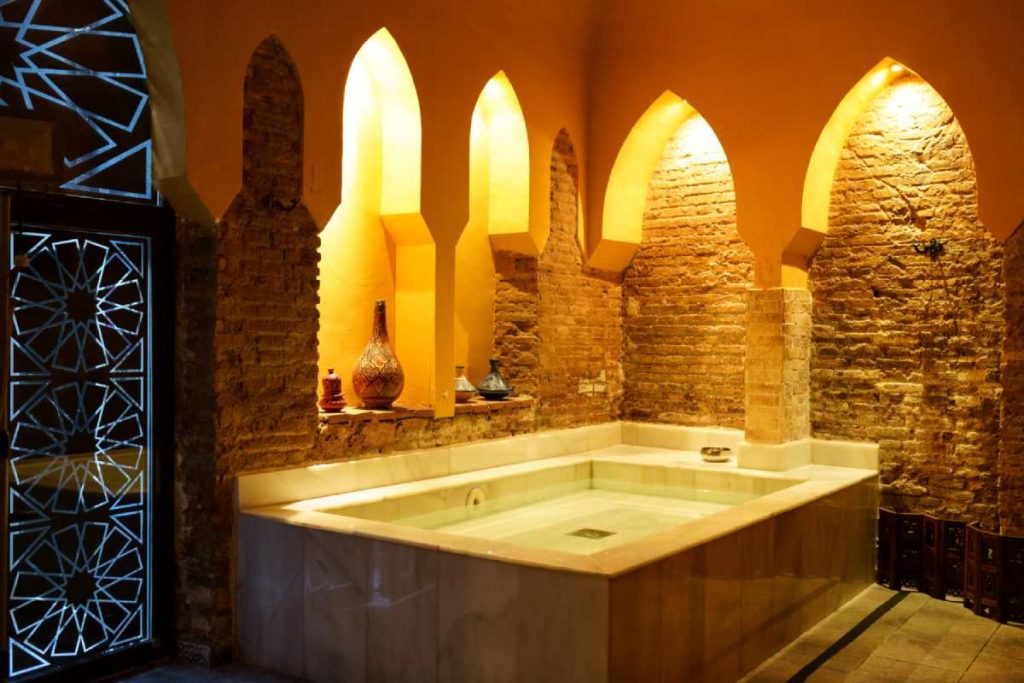Preparing for the Traditional Hammam Visit
Before stepping into a Traditional Hammam, guests are welcomed into a peaceful changing area where they are provided with essentials like a pestemal (a thin cotton towel), slippers, and sometimes disposable underwear. This moment of preparation marks the beginning of the Traditional Hammam experience, inviting the guest to leave behind distractions and embrace the cleansing ritual ahead.
Acclimating in the Warm Room of the Traditional Hammam
The first stage of a Traditional Hammam takes place in a warm, dry area where the body begins to adjust to the heat. This stage allows the pores to open gradually and encourages gentle sweating. By spending time in this initial area, guests begin to mentally and physically transition into the rejuvenating environment of the Traditional Hammam.
Experiencing the Steam Ritual of the Traditional Hammam
Next, visitors are guided into the central steam room of the Traditional Hammam, often built with marble benches and domed ceilings. The dense, moist heat penetrates the skin and relaxes the muscles. Within the Traditional Hammam, the steam acts as a natural detoxifier, helping the body eliminate impurities while preparing the skin for the treatments that follow.
The Scrubbing Ritual in the Traditional Hammam
Arguably the most iconic part of the Traditional Hammam experience is the exfoliating scrub. A professional attendant uses a “kese” mitt to scrub away dead skin cells across the body. This vigorous yet refreshing step in the Traditional Hammam not only removes built-up dirt and dead skin but also improves blood circulation and reveals a healthy, smooth layer of skin underneath.
Foam Massage and Cleansing in the Traditional Hammam
After the scrub, guests are treated to a relaxing foam massage using olive oil or natural soap. In a true Traditional Hammam, the foam is created with a special cloth that traps air and creates luxurious bubbles. This stage enhances relaxation while cleansing the body further. The warm water rinsing that follows completes the cleansing cycle in the Traditional Hammam, leaving guests feeling renewed and purified.
Resting and Rehydrating After the Traditional Hammam
After the main treatments, guests are invited to a cool resting room. Here, they can relax, sip herbal tea or water, and allow their body temperature to normalize. This final phase of the Traditional Hammam helps extend the benefits of the ritual by giving the body time to absorb the experience. Rehydration is key, especially after the intense steam and exfoliation of the Traditional Hammam.
Conclusion
The Traditional Hammam is a journey of purification, relaxation, and cultural immersion. Each stage—from warming and steaming to scrubbing and resting—has been passed down through generations. The Traditional Hammam is more than just a cleansing ritual; it’s a sensory and spiritual experience that leaves you refreshed, rebalanced, and deeply connected to tradition.
Frequently Asked Questions
- What is the purpose of a Traditional Hammam?
The Traditional Hammam aims to deeply cleanse the body, improve circulation, and promote relaxation. - How long does a Traditional Hammam session last?
A complete Traditional Hammam experience usually takes between 60 and 90 minutes. - Do I need to bring anything with me?
Most Traditional Hammam facilities provide towels and slippers, but you can bring personal toiletries if preferred. - Is the scrub painful in a Traditional Hammam?
The scrub in a Traditional Hammam is firm but not painful; attendants adjust to your comfort level. - Can I go to a Traditional Hammam if I have sensitive skin?
Yes, but inform the staff beforehand so they can take extra care during your Traditional Hammam treatment. - Are there separate areas for men and women?
Most Traditional Hammam facilities offer gender-specific areas or time slots. - Is tipping expected in a Traditional Hammam?
Yes, it’s customary to tip your attendant after your Traditional Hammam session. - What should I wear inside the Traditional Hammam?
You’ll wear a pestemal, which is provided by the Traditional Hammam, along with slippers. - Can I go alone to a Traditional Hammam?
Absolutely. A Traditional Hammam is a great solo self-care experience, though many go in groups as well. - Is it okay to talk during the session?
Quiet conversation is fine, but many people prefer silence to fully enjoy the Traditional Hammam experience.
